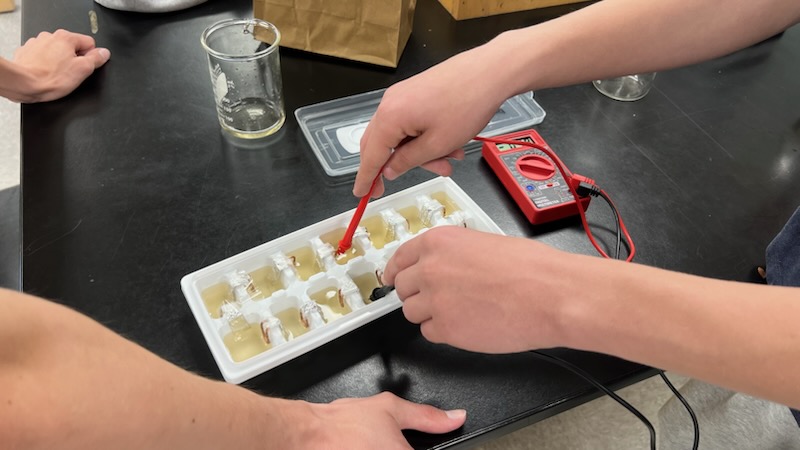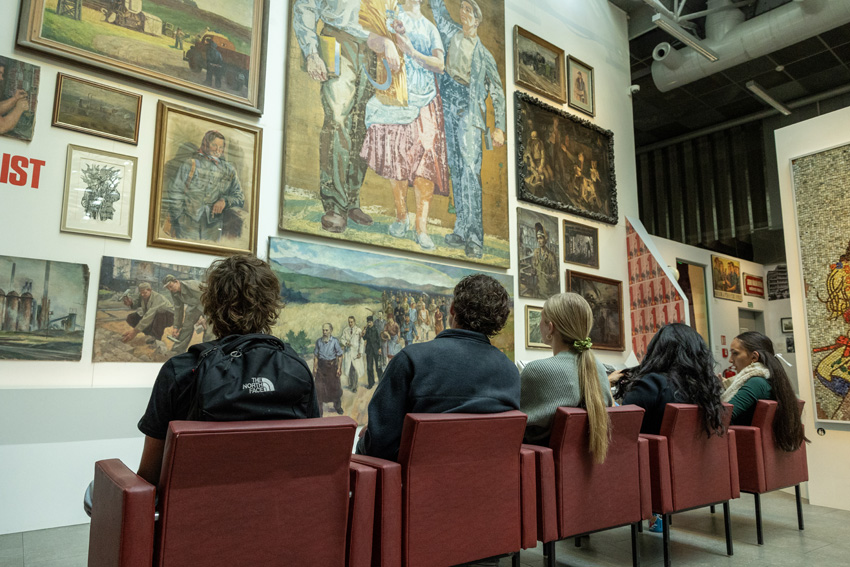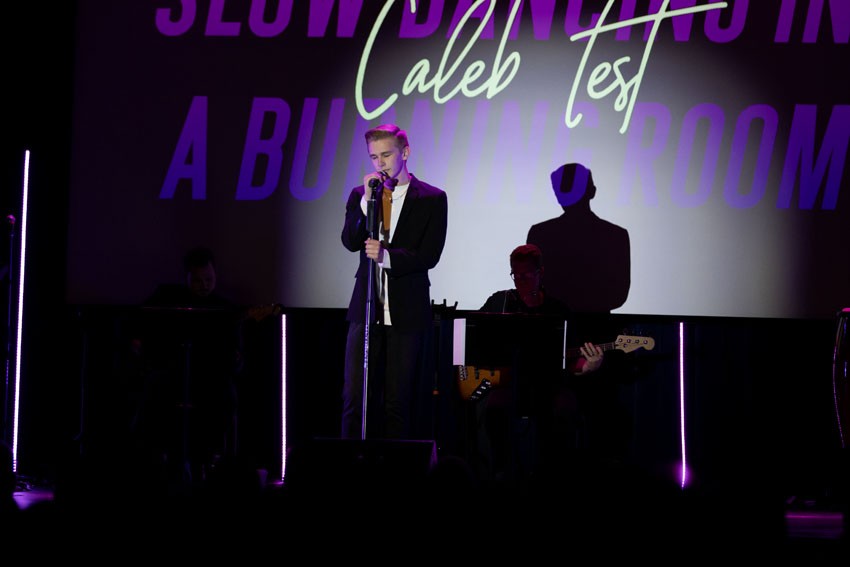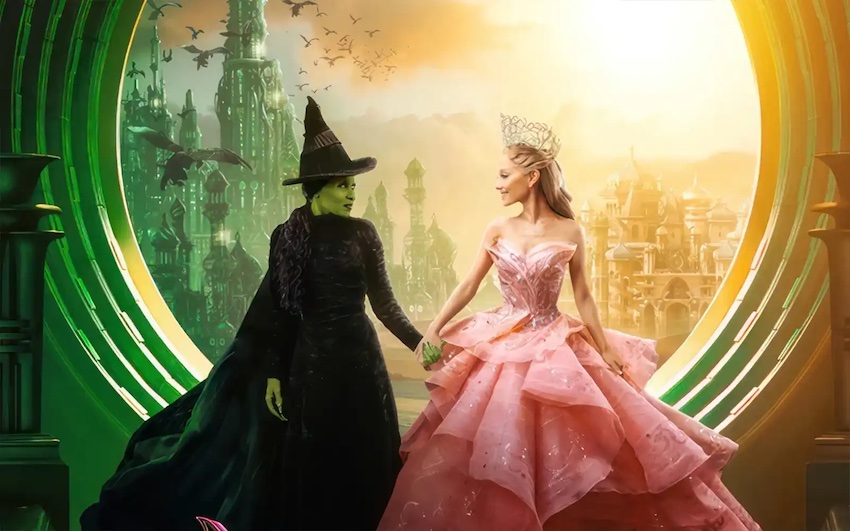[media-credit name=”Courtesy of Jenna Weimer” align=”alignright” width=”300″] [/media-credit]To give the community a step back into the past, the Warnors Theatre hosted a Return to the Silent Movies, beginning in September 2013, replaying films such as The Phantom of the Opera (1925), The Gold Rush (1925) and Hot Water (1924) as they would have originally come out in the early 1900s.
[/media-credit]To give the community a step back into the past, the Warnors Theatre hosted a Return to the Silent Movies, beginning in September 2013, replaying films such as The Phantom of the Opera (1925), The Gold Rush (1925) and Hot Water (1924) as they would have originally come out in the early 1900s.
Opened in 1928, Warnors Theatre, first known as the Pantages Theatre, was used mainly for sound pictures, although with the installation of a theater organ, it was originally designed to play silent films.
For the fifth night of the series, the theater showed The Great Train Robbery (1903) and Buster Keaton’s The General (1926), Jan. 16 at 7 p.m.
Attendees were invited to dress in outfits from the 1920s for the occasion, and the evening began with a contest for the best railroad conductor costumes, male and female, followed by a competition for the kids to see who could make the best train whistle sound with his mouth. After a brief introduction and history of silent films, the main performer for the evening was introduced.
Dave Moreno, organist from Carmichael, California, began playing the theater organ when he was about 12 years old. As a musician, he enjoyed the notion of being a one-man band, and he has continued to play ever since.
“When I was a little kid, I wanted to play every instrument in the orchestra,” Moreno said. “I found a theater organ that had all the instruments and there I was.”
Moreno’s career of playing the theater organ, also known as the pipe organ, began at a local pizza parlor, where he played in “Pizza and Pipes” performances. Eventually he tried accompanying silent cartoons and from there he began to play along with silent movies. Through his time playing at Pizza and Pipes and his side-job of fixing theater organs, Moreno was discovered by the silent film staff at Warnor’s Theatre.
“During the day, I take care of theater organs, building, designing and installing them,” Moreno said. “I used to work on the organ here [at Warnor’s Theatre] with another guy, but I never played it publicly. When they started doing silent movies in September, the house organist knew me from Pizza and Pipes that I played especially for silent films and they got a hold of me through him.”
Moreno does not write his own music to accompany the films, although in many instances, he must create filler music in between the songs he selects. Instead, he searches for pieces from the time around the movie’s release to make the audience’s experience more realistic and specific to that time period.
“I watch the movie, look at the time period the movie is in and look for music from that time period and earlier to use, but a lot of time I’m doing improv work between scenes when there really isn’t any music involved,” Moreno said. “What I try to do is put all of the sound effects in, so when you’re watching the movie, it’s like it has sound. People walk away thinking I wasn’t there, and that’s when I’m doing a good job.”
Heidi Buller, high school student attendee, came to the event with her grandpa because of her fondness for history and curiosity for the night’s events. Although she was not sure what the night would hold, she was eager to learn a bit about the silent movie era.
“My grandpa was going and he asked me to come with him,” Buller said. “It sounded interesting because I like old things like this and it sounded fun. I don’t know what to expect, but I’m a little excited and I’m hoping to learn a little bit about that time period.”
The first silent film of the evening was The Great Train Robbery (1903), a story of two bandits who rob the passengers of a passing locomotive but are eventually killed in their escape. Produced by Thomas Edison and directed by Edwin S. Porter, The Great Train Robbery, the first ever narrative movie, starred Gilbert M. “Broncho Billy” Anderson and became extremely popular across America in 1904.
Once The Great Train Robbery ended, including the famous shot of the bandit Daniels shooting into the audience, Moreno gave the audience a brief tour of the theater organ. Directly following his demonstration of the organ’s various instruments and sound effects, the first part of the evening’s feature presentation, the slapstick comedy film The General (1926), began.
The General, often considered one of the greatest silent comedies ever made, is set during the Civil War and tells the tale of a Confederate engineer named Johnnie Gray whose train, The General, is captured by the Union army to be used in a sneak attack against the South. In the seizing of Johnnie’s train, the North has also accidentally taken his girlfriend, Annabelle Lee. In a high-speed chase across enemy lines, Johnnie recovers his beloved engine and lady and warns the Confederate generals of the coming Union attack.
The night was ended by a bonus showing of the The Iron Mule, a 1925 comedy film directed by Roscoe “Fatty” Arbuckle and starring Buster Keaton and Al St. John. Set in 1830, the movie is a story of a train called the Iron Mule, which, loaded with passengers, sets off toward its destination and runs into many obstacles along the way, including a band of Indians.
Michelle Swift, volunteer coordinator and program director at Warnors Theatre, says the “Return to the Silent Movies” series was created so the Fresno community could encounter a past time period and experience the theater as it was created back in the early twentieth century.
“We wanted to showcase the theater in the way it would have originally been seen when it opened in 1928,” Swift said. “We also wanted to get the community in here, have them experience a bygone era in a building that was built during that period of time and hopefully gain an appreciation for it.”
Moreno believes that it is important to have these kinds of historical events because it gives the younger generations a glimpse into a completely different time period and the older generations a return to their childhoods. In his opinion, one cannot achieve the full experience by simply watching silent movies on TV at home.
Although the event was put on to allow younger generations to experience the movies as they were first created in the early 1900s, it also provided a trip back in time for older folks who grew up watching these films. One such audience member, 92-year-old Al Agnew, was greeted with a return to his childhood when he arrived at the theater and sat down to watch the show.
“This film is from my generation and age,” Agnew said. “I was alive during those years. He [Buster Keaton] was a hero to a lot of us. When I was a boy, my parents called me ‘Buster’, and you can guess where that came from. We never left that time, never grew up.”
As a boy, Agnew saw many silent movies at the theater where he worked in the early 1930s, passing out flyers promoting the theater’s upcoming films.
“I worked at a theater, handing out handouts showing the coming attractions,” Agnew said. “I would walk around town and at every door leave a flyer of what movies were playing at the theater that week. Getting to see the shows was part of our pay, so I watched a lot of these movies as they were coming out.”
Agnew was glad that the theater decided to put on the event, not only for the step back into his childhood that it provided but also for the history of the time period that it presented to its audience.
“I’m looking forward to seeing these actors we heard about all those years and just the whole silent movie seeing,” Agnew said. “It’s fun to look at, and it’s good historically. It backs up some things and corrects some thoughts that people have about the past and the history of theaters like this. It’s just good to know about.”
Swift says that, while people may be able to gain a bit of knowledge about a time period by reading about it in a book or hearing about it from grandparents, the only way to really learn about it is to experience it for themselves.
“I think there’s a big difference between studying cultural norms of a time and actually experiencing an event that would make you feel like you’re in that decade,” Swift said. “Here it feels like you’ve stepped back in time and you’re actually at the silent film theater in the 1920s.”
As part of their “Return to the Silent Movies” series, Warnors Theater will next be showing Pollyanna (1920), What Drink Did (1909) and The Narrow Road (1912). Doors will open one hour prior to each show time, and a costume contest will be held before the films. Tickets are $3/individual and $8/family and can be purchased at the door.
The next showing at Warnors Theatre will be of POLLYANNA (1920), What Drink Did (1909) and The Narrow Road (1912), Feb. 20. For presale tickets, call the box office at 559.264.2848.
For more information on upcoming events at Warnors Theater, visit www.warnorstheater.org.
For more on the “Return to the Silent Movies” series, see the Oct. 24 article, Reshowing old-time film disappoints senior, pipe organ impresses.
This writer can be reached via Twitter: @JennaWeimer42. FollowThe Feather via Twitter: @thefeather. Follow the Warnors Theatre via Twitter: @WarnorsCenter.
For more features, read the Jan. 30 article, Junior class reinvents classic film, bond.







Brooke Wood • Aug 30, 2013 at 12:14 am
Katie did a great job this year. So glad she was my flyer